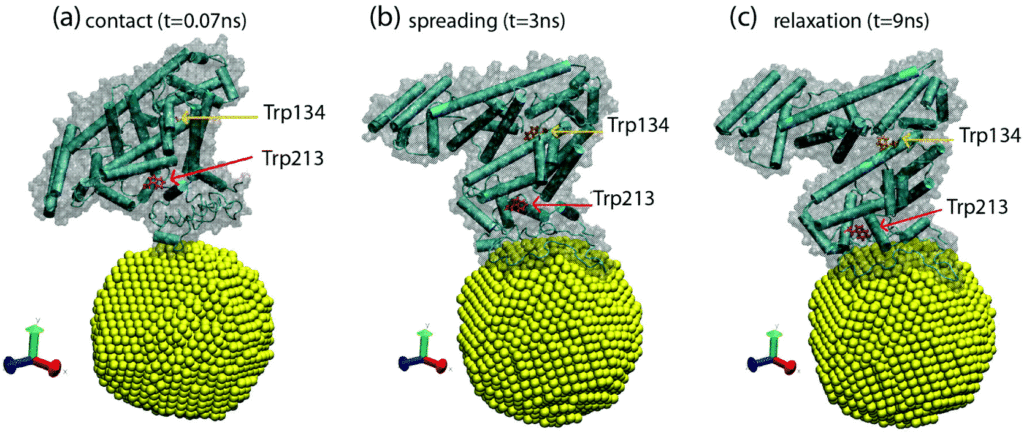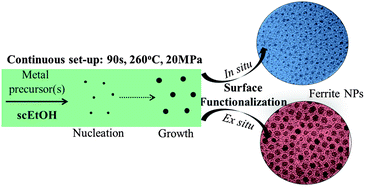Hot off the press: paper published in Nanoscale!
New paper “PLGA protein nanocarriers with tailor-made fluorescence/MRI/PET imaging modalities” authored by Yajie Zhang and Anna Roig was published today in Nanoscale. Irene co-authored the article.
Written by Jan Grzelak on . Posted in New publications, Uncategorized.
New paper “PLGA protein nanocarriers with tailor-made fluorescence/MRI/PET imaging modalities” authored by Yajie Zhang and Anna Roig was published today in Nanoscale. Irene co-authored the article.
Written by Irene Anton on . Posted in New publications.
The paper entitled “Nanoclusters of crystallographically aligned nanoparticles for magnetic thermotherapy: aqueous ferrofluid, agarose phantoms and ex vivo melanoma tumour assessment” has recently been published on the Nanoscale Journal. We congratulate Anna Roig and our collaborator Marcela Fernández for being authors of this nice study!
Abstract: Magnetic hyperthermia is an oncological therapy where magnetic nanostructures, under a radiofrequency field, act as heat transducers increasing tumour temperature and killing cancerous cells. Nanostructure heating efficiency depends both on the field conditions and on the nanostructure properties and mobility inside the tumour. Such nanostructures are often incorrectly bench-marketed in the colloidal state and using field settings far off from the recommended therapeutic values. Here, we prepared nanoclusters composed of iron oxide magnetite nanoparticles crystallographically aligned and their specific absorption rate (SAR) values were calorimetrically determined in physiological fluids, agarose-gel-phantoms and ex vivo tumours extracted from mice challenged with B16-F0 melanoma cells. A portable, multipurpose applicator using medical field settings; 100 kHz and 9.3 kA m−1, was developed and the results were fully analysed in terms of nanoclusters’ structural and magnetic properties. A careful evaluation of the nanoclusters’ heating capacity in the three milieus clearly indicates that the SAR values of fluid suspensions or agarose-gel-phantoms are not adequate to predict the real tissue temperature increase or the dosage needed to heat a tumour. Our results show that besides nanostructure mobility, perfusion and local thermoregulation, the nanostructure distribution inside the tumour plays a key role in effective heating. A suppression of the magnetic material effective heating efficiency appears in tumour tissue. In fact, dosage had to be increased considerably, from the SAR values predicted from fluid or agarose, to achieve the desired temperature increase. These results represent an important contribution towards the design of more efficient nanostructures and towards the clinical translation of hyperthermia.
Written by Anna May on . Posted in New publications, News.
Good news! One of our last published articles in Nanoscale was the main star of the inside cover of the journal (Issue 30, Volume 8, 2016).
Written by Anna Roig on . Posted in New publications, News.
Albumin-coated SPIONs: An experimental and theoretical evaluation of protein conformation, binding affinity, and competition with serum proteins, by Siming Yu, Alex Perálvarez-Marín, Caterina Minelli, Jordi Faraudo, Anna Roig* and Anna Laromaine*, has just been accepted for publication in Nanoscale, DOI: 10.1039/C6NR01732K.
 Among inorganic nanoparticles, superparamagnetic iron oxide nanoparticles (SPIONs) show great promise for medicine. In this work, we study in detail the formation, composition, and structure of a monolayer of bovine serum albumin (BSA) on SPIONs. We determine, both by molecular simulations and experimentally, that ten molecules of BSA form a monolayer of BSA around the SPIONs and their binding strength to the SPIONs is about 3.5×10–4 M, ten times higher than the adsorption of fetal bovine serum (FBS) on the same SPIONs. We elucidate a strong electrostatic interaction between BSA and the SPIONs, although the secondary structure of the protein is not affected. We present data that supports the strong binding of the BSA layer on SPIONs and the properties of the BSA layer as a protein-resistant coating. We believe that a complete understanding of the behavior and morphology of BSA-SPIONs and how the protein interacts with SPIONs is crucial for improving NP surface design and expanding the potential applications of SPIONs in nanomedicine.
Among inorganic nanoparticles, superparamagnetic iron oxide nanoparticles (SPIONs) show great promise for medicine. In this work, we study in detail the formation, composition, and structure of a monolayer of bovine serum albumin (BSA) on SPIONs. We determine, both by molecular simulations and experimentally, that ten molecules of BSA form a monolayer of BSA around the SPIONs and their binding strength to the SPIONs is about 3.5×10–4 M, ten times higher than the adsorption of fetal bovine serum (FBS) on the same SPIONs. We elucidate a strong electrostatic interaction between BSA and the SPIONs, although the secondary structure of the protein is not affected. We present data that supports the strong binding of the BSA layer on SPIONs and the properties of the BSA layer as a protein-resistant coating. We believe that a complete understanding of the behavior and morphology of BSA-SPIONs and how the protein interacts with SPIONs is crucial for improving NP surface design and expanding the potential applications of SPIONs in nanomedicine.
Written by Anna Roig on . Posted in New publications, News.
Siming Yu,a Jordan A. Hachtel,bc Matthew F. Chisholm,c Sokrates T. Pantelides,bc Anna Laromaine*a and Anna Roig*a
Nanoscale, 2015,7, 14039-14046, DOI: 10.1039/C5NR03113C
Received 12 May 2015, Accepted 16 Jul 2015, First published online 21 Jul 2015

Simple approaches to synthesize hybrid nanoparticles with magnetic and plasmonic functionalities, with high control of their shape and avoiding cytotoxic reactants, to target biomedical applications remain a huge challenge. Here, we report a facile, fast and bio-friendly microwave-assisted polyol route for the synthesis of a complex multi-material consisting of monodisperse gold nanotriangles around 280 nm in size uniformly decorated by superparamagnetic iron oxide nanoparticles of 5 nm. These nanotriangles are readily dispersible in water, display a strong magnetic response (10 wt% magnetic fraction) and exhibit a localized surface plasmon resonance band in the NIR region (800 nm). Moreover, these hybrid particles can be easily self-assembled at the liquid–airinterfaces.
Written by JAGS on . Posted in New publications, News.
 A Nanoscale paper on “Ultrafast continuous synthesis of crystalline ferrite nanoparticles in supercritical ethanol” (Oana Pascu, Samuel Marre, Cyril Aymonier and Anna Roig) has recently been published. It is the result from the collaboration with the group of Cyril Aymonier from the ICMB-CNRS in Bordeaux, where Oana Pascu spent an internship during her Ph.D. and now she holds a post-doctoral contract.
A Nanoscale paper on “Ultrafast continuous synthesis of crystalline ferrite nanoparticles in supercritical ethanol” (Oana Pascu, Samuel Marre, Cyril Aymonier and Anna Roig) has recently been published. It is the result from the collaboration with the group of Cyril Aymonier from the ICMB-CNRS in Bordeaux, where Oana Pascu spent an internship during her Ph.D. and now she holds a post-doctoral contract.
Nanoscale 5 (2013) 2126-2132, DOI: 10.1039/c3nr33501a
Magnetic nanoparticles (NPs) are of increasing interest in various industrially relevant products. For these, the development of greener and faster approaches facilitating scaling-up production is of paramount importance. Here, we report a novel, green and potentially scalable approach for the continuous and ultrafast (90 s) synthesis of superparamagnetic ferrite NPs (MnFe2O4, Fe3O4) in supercritical ethanol (scEtOH) at a fairly moderate temperature (260 °C). ScEtOH exhibits numerous advantages such as its production from bio-resources, its lack of toxicity and its relatively low supercritical coordinates (pc = 6.39 MPa and Tc = 243 °C), being therefore appropriate for the development of sustainable technologies. The present study is completed by the investigation of both in situ and ex situ NP surface functionalization. The as-obtainednanoparticles present good crystallinity, sizes below 8 nm, superparamagnetic behavior at room temperature and high saturation magnetization. Moreover, depending on the capping strategy, the ferrite NPs present extended (for in situ coated NPs) or short-term (for ex situ coated NPs) colloidal stability.
The N&N group participates in the @NextGEM_eu project, for which we prepared this video explaining how we work with c.elegans. 🪱
👉 Dr. @PolAlonso1 explains how we use these nematodes and why they are useful for assessing biological effects.
#BioEM #5G
We are thrilled to announce that Dr. @AnnaRoig8 from the @NNgroupICMAB research group (@icmabCSIC, Barcelona, Spain) will be offering a talk on "Opportunities of bacterial nanocellulose in healthcare". This Wednesday at 12.15h at the BBT Weekly Meetings, at @EEBE_UPC